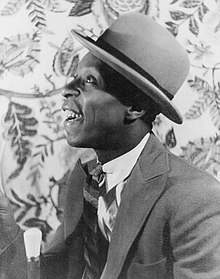Buck and Bubbles
| John W. Bubbles | |
|---|---|

Portrait (as Sportin' Life in Porgy and Bess) by Carl Van Vechten, 1935 Dec. 27.
|
|
| Born |
February 19, 1902 Louisville, Kentucky |
| Died | May 18, 1986 (aged 84) Baldwin Hills, California |
| Occupation | Vaudeville performer and tap dancer |
John William Sublett (February 19, 1902 – May 18, 1986), known by his stage name John W. Bubbles, was a vaudeville performer. He performed in the duo "Buck and Bubbles." He is also known as the father of "rhythm tap."
He was born in Louisville, Kentucky on February 19, 1902, but soon moved with his family to Indianapolis. There, he formed a partnership with Ford L. "Buck" Washington in 1919. Their duo was known as "Buck and Bubbles." Buck played on the stride piano and sang, and Bubbles tapped along. They were so popular that the duo moved to Manhattan, New York City in September of that year. They played together in the Columbia Theater, the Palace and played with artists Al Jolson, Eddie Cantor and Danny Kaye. They were on the Ziegfeld Follies of 1931. They also became the first black artists to perform at the Radio City Music Hall. "Buck and Bubbles" performed live in the first scheduled 'high definition' television program on November 2, 1936 at Alexandra Palace, London, for the BBC, becoming the first black artists on television anywhere in the world.
Though unable to read music, Bubbles was chosen by George Gershwin to create the role of Sportin' Life in his opera Porgy and Bess in 1935. Since he didn't understand the music score, Gershwin spent the time to teach it to him as a tap rhythm. Sublett caused some problems because he often made up rhythms which caused confusion with other members of the cast. Sublett performed the role occasionally for the next two decades. In 1963, in a studio recording of Porgy and Bess featuring Leontyne Price and William Warfield, he performed Sportin' Life's two main arias from the opera, "It Ain't Necessarily So" and "There's A Boat Dat's Leavin' Soon For New York".
...
Wikipedia
